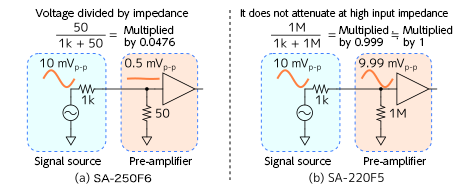Posted 2019/7/19
Among the preamplifiers in our lineup, SA-250F6 has the lowest equivalent input noise voltage density (0.25 nV/√Hz typ.).
Even so, does SA-250F6 provide the best performance in any application? The answer to that question is “no” because SA-250F6 is only suitable for specific uses. For that reason, we offer a lineup that makes it possible to select a preamplifier that matches each application.
The signal source (sensor) always has output impedance. In general, it is desirable that the input impedance of the preamplifier is high; however, the output impedance of the signal source is low, and, in reality, they are both finite values and do not become infinity or zero.
SA-250F6 has an input impedance of only 50 Ω because it is designed to be optimized for a 50 Ω system.
For that reason, it is not the best one to amplify a signal output from a high-output-impedance signal source like a piezoelectric element. If the output impedance is as high as 1 kΩ, the signal is attenuated to about 1/20 at the input terminal of SA-250F6 (Figure).
In the case of such high output impedance, it is better to select a model amplifier with high input impedance.
For example, SA-220F5 is a preamplifier with input impedance of 1 MΩ. Even sensors with output impedance of 1 kΩ can be used with it without concern for attenuation.
Figure

Related keywords : Ultra low noise amplifier, LNA